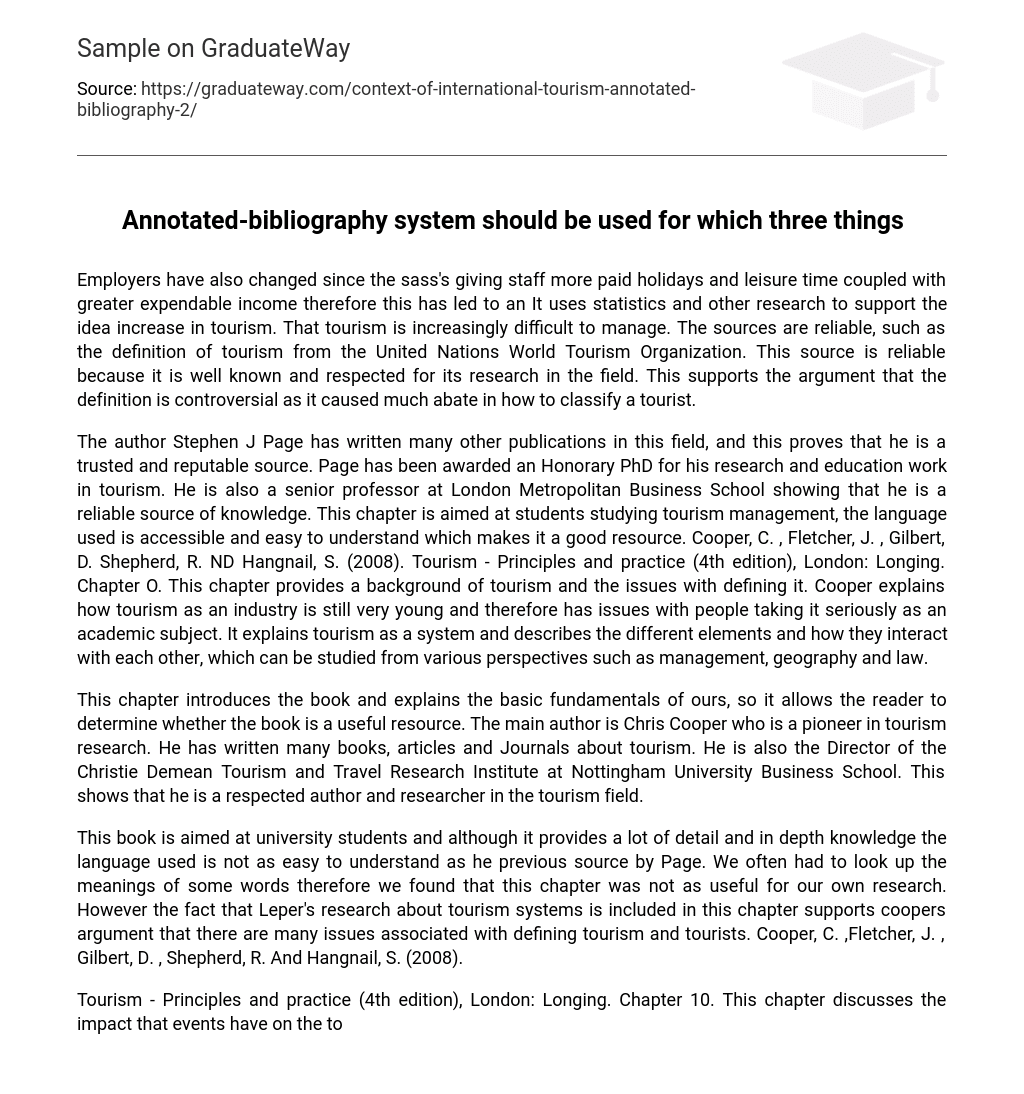Employers have also changed since the sass’s giving staff more paid holidays and leisure time coupled with greater expendable income therefore this has led to an It uses statistics and other research to support the idea increase in tourism. That tourism is increasingly difficult to manage. The sources are reliable, such as the definition of tourism from the United Nations World Tourism Organization. This source is reliable because it is well known and respected for its research in the field. This supports the argument that the definition is controversial as it caused much abate in how to classify a tourist.
The author Stephen J Page has written many other publications in this field, and this proves that he is a trusted and reputable source. Page has been awarded an Honorary PhD for his research and education work in tourism. He is also a senior professor at London Metropolitan Business School showing that he is a reliable source of knowledge. This chapter is aimed at students studying tourism management, the language used is accessible and easy to understand which makes it a good resource. Cooper, C. , Fletcher, J. , Gilbert, D. Shepherd, R. ND Hangnail, S. (2008). Tourism – Principles and practice (4th edition), London: Longing. Chapter O. This chapter provides a background of tourism and the issues with defining it. Cooper explains how tourism as an industry is still very young and therefore has issues with people taking it seriously as an academic subject. It explains tourism as a system and describes the different elements and how they interact with each other, which can be studied from various perspectives such as management, geography and law.
This chapter introduces the book and explains the basic fundamentals of ours, so it allows the reader to determine whether the book is a useful resource. The main author is Chris Cooper who is a pioneer in tourism research. He has written many books, articles and Journals about tourism. He is also the Director of the Christie Demean Tourism and Travel Research Institute at Nottingham University Business School. This shows that he is a respected author and researcher in the tourism field.
This book is aimed at university students and although it provides a lot of detail and in depth knowledge the language used is not as easy to understand as he previous source by Page. We often had to look up the meanings of some words therefore we found that this chapter was not as useful for our own research. However the fact that Leper’s research about tourism systems is included in this chapter supports coopers argument that there are many issues associated with defining tourism and tourists. Cooper, C. ,Fletcher, J. , Gilbert, D. , Shepherd, R. And Hangnail, S. (2008).
Tourism – Principles and practice (4th edition), London: Longing. Chapter 10. This chapter discusses the impact that events have on the tourism trade and the importance of managing them to minimize the damage to a tourist destination. It explains the way that tourists view terrorist attacks and natural disasters and how these can affect their choice of holiday destination. The chapter outlines how climatic change has affected the industry both directly and indirectly. This change can impact dramatically on vulnerable destinations especially islands and winter sport resorts.
The author uses many recent and up to date examples of threats to tourism such as 9/1 1 . This makes it easier to relate to for university students, which the chapter is mimed at. Charts and graphs are used to illustrate and display information in an easy to read format which make it clearer to understand and reinforce the point. The use of subtitles makes it easier for the reader to find a specific section, which is helpful when trying to locate information for research. This chapter is written by Bas Enameling and Hagen Morality, both have Pad’s and have contributed to many books, Journals and research in tourism.
This shows that they are actively involved in this sector this makes them credible and reliable sources. There are 2 case studies, which make the reading more interesting as the information seems more relevant and allows the reader to see how it can be applied to different scenarios. Buttonholer Henchman. Chapter 9. This chapter discusses the pressures that tourist attractions face and the growing demands of tourists. It is clear from the research in this chapter that tourists now want more of an experience from visiting an attraction. This is because it explains the key factors that influence their success.
Finally the chapter discusses the importance of managing an attraction for the future in order for it to be successful. The use of case studies provides a real world example that brings the theory to life. We found that this really helped us to understand the theories contained within this chapter. The use of tables to display the information makes it clearer for the reader to see comparisons between different tourist attractions. Photographs provide a good visual aid for the reader breaking up long chunks of text and help you understand what is being discussed.





